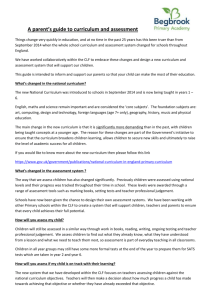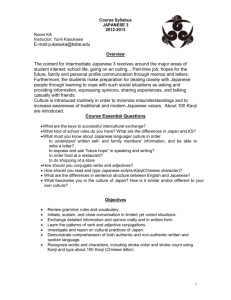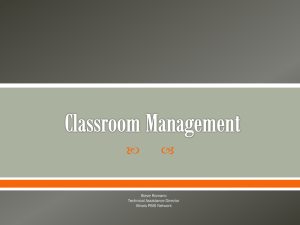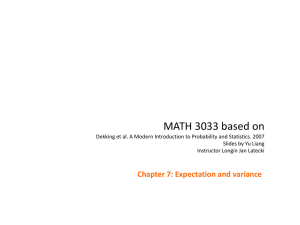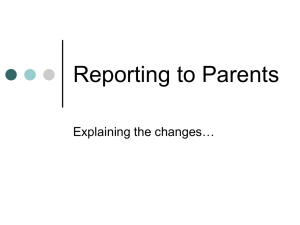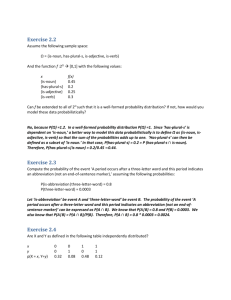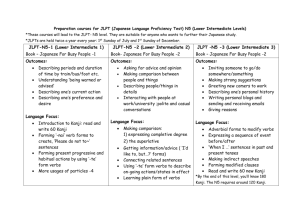AP Project Interview to Japanese people
advertisement
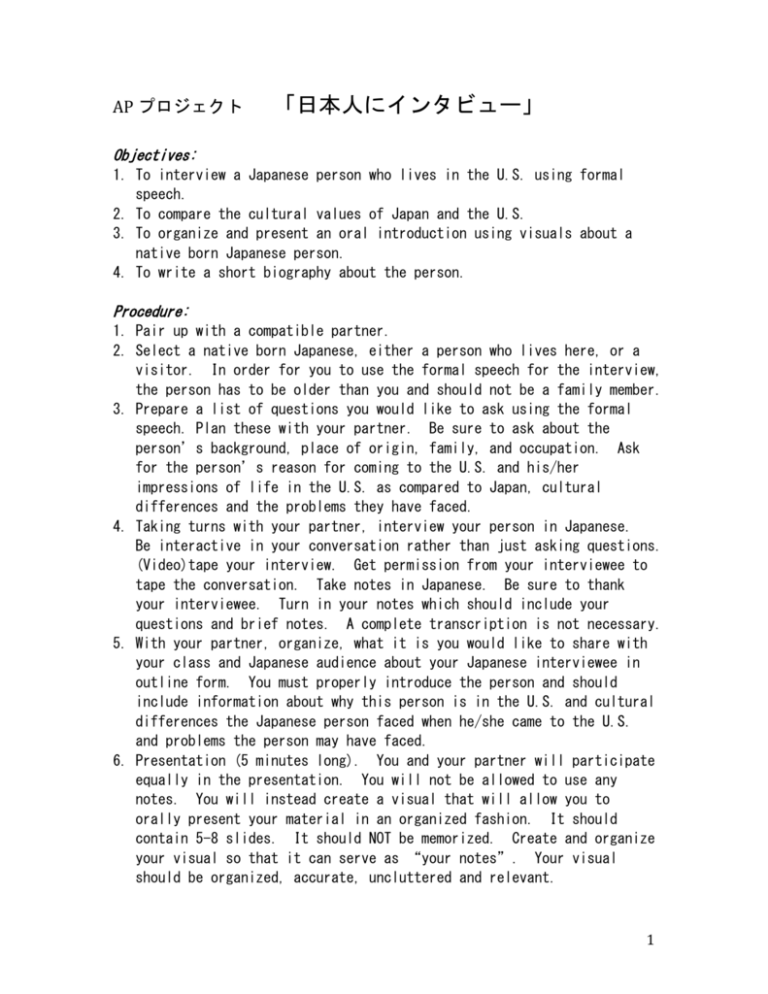
AP プロジェクト 「日本人にインタビュー」 Objectives: 1. To interview a Japanese person who lives in the U.S. using formal speech. 2. To compare the cultural values of Japan and the U.S. 3. To organize and present an oral introduction using visuals about a native born Japanese person. 4. To write a short biography about the person. Procedure: 1. Pair up with a compatible partner. 2. Select a native born Japanese, either a person who lives here, or a visitor. In order for you to use the formal speech for the interview, the person has to be older than you and should not be a family member. 3. Prepare a list of questions you would like to ask using the formal speech. Plan these with your partner. Be sure to ask about the person’s background, place of origin, family, and occupation. Ask for the person’s reason for coming to the U.S. and his/her impressions of life in the U.S. as compared to Japan, cultural differences and the problems they have faced. 4. Taking turns with your partner, interview your person in Japanese. Be interactive in your conversation rather than just asking questions. (Video)tape your interview. Get permission from your interviewee to tape the conversation. Take notes in Japanese. Be sure to thank your interviewee. Turn in your notes which should include your questions and brief notes. A complete transcription is not necessary. 5. With your partner, organize, what it is you would like to share with your class and Japanese audience about your Japanese interviewee in outline form. You must properly introduce the person and should include information about why this person is in the U.S. and cultural differences the Japanese person faced when he/she came to the U.S. and problems the person may have faced. 6. Presentation (5 minutes long). You and your partner will participate equally in the presentation. You will not be allowed to use any notes. You will instead create a visual that will allow you to orally present your material in an organized fashion. It should contain 5-8 slides. It should NOT be memorized. Create and organize your visual so that it can serve as “your notes”. Your visual should be organized, accurate, uncluttered and relevant. 1 7. After your oral presentation you will be individually writing a more detailed composition about the person. This should provide more information than you were able to talk about in your presentation. Elaborate and expand on the areas you touched on in the presentation. Use plain forms and Kanji. Use as many new vocabulary and structures you can, while incorporating a variety of structures from earlier levels of Japanese. Be organized and be sure your composition flows well. Check the composition rubric provided to you by 先生。The report must be typewritten. 8. You will write a thank you card to the person you interviewed in Japanese for sharing their life stories and experiences with you. Evaluation and Due Dates: 1. 2. 3. 4. 5. 6. Interview notes and Interview video (Group points) -Oral presentation (Individual and Group points) -Visual aid (Individual and Group points) -Composition (Individual points) -Reflection (Individual points) -Thank you note (Individual points) -- Rubrics: Interview Group points Interview Notes: Expectation—Questions and answers written in Japanese; used all previously learned kanji and many new grammatical structures, formal speech style and vocabulary accurately and appropriately. 10 – 9 8–7 6–5 4–3 2–1 Met all expectations Met most expectations Satisfactorily met expectations Met few expectations Did not meet most expectations Interview (Video)tape: Expectation –Entire interview was conducted in Japanese, using correct speech form and appropriate grammar and vocabulary. Received abundant information and conducted interview in an interactive manner. 10 – 9 8–7 Met all expectations Met most expectations 2 6–5 4–3 2–1 Satisfactorily met expectations Met few expectations Did not meet most expectations Presentation Individual Points Use of Language: Expectation—Used grammar and vocabulary appropriately and accurately; used a variety of grammatical structures, including those recently learned. Message communicated effectively. 10 – 9 8–7 6–5 4–3 2–1 Met all expectations Met most expectations Satisfactorily met expectations Met few expectations Did not meet most expectations Pronunciation and intonation: Expectation—Pronunciation and intonation easily understood by a native speaker, and does not interfere with communication. 6–5 4–3 2–1 Satisfactorily met expectations Met few expectations Did not meet most expectations Delivery: Expectation—Projected voice well, maintained steady eye contact, addressed entire audience, and used appropriate body language. 8–7 6–5 4–3 2–1 Group Points: Fully met expectations Met most expectations Satisfactorily met expectations Did not meet most expectations Content: Expectation—Provided ample and relevant information of high interest. Creatively approached. 8–7 6–5 4–3 2–1 Met expectations Satisfactorily met expectations Met few expectations Did not meet most expectations Flow/Organization: Expectation—Entire presentation flowed naturally, was well prepared and organized. Showed group collaboration, effectively and creatively presented. 8–7 6–5 4–3 2–1 Met expectations Satisfactorily met expectations Met few expectations Did not meet most expectations 3 Visuals Group Points Slideshow: Expectation—Used effective slide show presentation for 5 minutes. 8–7 Met expectations 6–5 Satisfactorily met expectations 4–3 Met few expectations 2–1 Did not meet most expectations Content: Expectation—Selection of slide were relevant and appropriate and effectively supplemented presentation. 8–7 Met expectations 6–5 Satisfactorily met expectations 4–3 Met few expectations 2–1 Did not meet most expectations Text: Expectation—Text was written in Japanese accurately and appropriately. Text was brief and concise. 8–7 Met expectations 6–5 Satisfactorily met expectations 4–3 Met few expectations 2–1 Did not meet most expectations Design: Expectation—Slides were organized, uncluttered, appealing, creative and effective. 8–7 Met expectations 6–5 Satisfactorily met expectations 4–3 Met few expectations 2–1 Did not meet most expectations Use of Visuals: Expectation—Used visuals effectively as ‘notes” on presentation. 6–5 Met all expectations 4–3 Met expectations 2–1 Met some expectations Composition Individual Points: Mechanics: Expectation—At least 2 typewritten pages, font-size 12, double-spaced, one-inch margins, not spacing errors, indented paragraphs, and use of correct punctuation. 8-7 Fully met expectations 6-5 Met most expectations 4-3 Satisfactory met expectations 4 2-1 Met a few expectations Use of Kanji and Katakana: Expectations—Used all previously learned kanji accurately and appropriately. Used Katakana accurately. 6-5 Met expectations 4-3 Satisfactory met expectations 2-1 Met a few expectations Content: Expectations—Well researched, highly informative, relevant, well developed and interesting. 10 – 9 Met all expectations 8–7 Met most expectations 6–5 Satisfactorily met expectations 4–3 Met some expectations 2–1 Did not meet most expectations Linguistic accuracy: Expectation—Used grammar and vocabulary accurately and appropriately. Communicated information with no interference from difficulties in used of grammar or vocabulary. Used plain form accurately and consistently. 10 – 9 Met all expectations 8–7 Met most expectations 6–5 Satisfactorily met expectations 4–3 Met some expectations 2–1 Did not meet most expectations Use of new vocabulary and structures: Expectation—Used a variety of recently learned grammar and vocabulary. 8–7 Fully met expectations 6–5 Met most expectations 4–3 Satisfactorily met expectations 2–1 Met a few expectations Organization, Cohesiveness, Development Expectation—Well-organized and cohesive, including introduction, body and conclusion. Used paragraphing, indentations and transitions well. Well developed. 8–7 Fully met expectations 6–5 Met most expectations 4–3 Satisfactorily met expectations 2–1 Met a few expectations Reflection Individual Points Content, Organization Expectation—Included all of the following; introduction, what was learned, opinions gained by doing the project, problems and successes encountered, detailed description of each 5 partner’s contribution to the project, conclusion and signature of partner indicating that the partner has read the reflection. 8-7 Met expectations 6-5 Satisfactorily met most expectations 4-3 Met some expectations 2-1 Did not meet most expectations Linguistic accuracy: Expectation—Used grammar and vocabulary accurately and appropriately. Used a variety of structures, including some recently learned structures and vocabulary. Used correct writing style. 8-7 Met expectations 6-5 Satisfactorily met most expectations 4-3 Met some expectations 2-1 Did not meet most expectations Use of Kanji: Expectation—Used all previously learned kanji accurately and appropriately. 4-3 Met expectations 2-1 Met some expectations Thank You Note Individual Points Format: Expectation—Followed the traditional letter-writing format. 4-3 Met expectations 2-1 Met some expectations Language usage: Expectation—Used expressions, grammar and vocabulary accurately and appropriately. Used a variety of structures and vocabulary, including a few of those recently learned. Used all previously learned kanji. Used formal speech style appropriately. 8-7 Met expectations 6-5 Satisfactorily met most expectations 4-3 Met some expectations 2-1 Did not meet most expectations Envelope: Expectation—Letter was enclosed in an unsealed fully addressed, stamped envelope. 4 Met expectations 6 7

